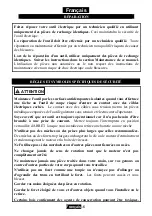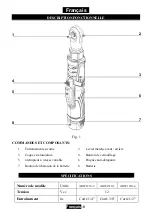
1
English
1
English
-9
OPERATION
Always check the direction of the rotation before use.
Please do not exceed the specification and scope of use based on the design, to
avoid endangering your personal safety and to prevent damaging the tool
2.
After continuous use, allow the ratchet wrench to sit idle for 2 minutes before
replacing the battery. The temperature of the motor, switch, etc., will rise if the
work is started again immediately after the battery has been changed, eventually
resulting in burned-out.
3.
Place the point of the bolt in the socket. Keep the tool pointed straight at the bolt.
4.
Apply forward pressure to the tool to prevent the socket from slipping off the bolt.
5.
To start, turn ratchet wrench. Always check torque with a torque wrench. The
fastening torque can be affected by many factors including the following:
Voltage:
Low voltage due to a nearly discharged battery will reduce the fastening
torque.
Socket Size:
Failure to use the correct socket size will cause a reduction in fastening
torque.
Variable Speed Trigger Switch:
Operating the tool at a reduced speed will reduce the
fastening torque.
Bolt Size:
Larger bolt diameters generally require higher fastening torque. Fastening
torque will also vary according to length, grade, and torque coefficient.
Material:
The type of material and surface finish of the material will affect fastening
torque.
Fastening Time:
Longer fastening time results in increased fastening torque. Using a
longer fastening time than recommended could cause the screws to be overstressed,
stripped or damaged.
Continuous use in variable speed range is not recommended. It may
damage the switch and should be avoided.
When change the position of the control button, making sure the variable
speed switch is released.
The first time the tool is run after changing the direction of rotation, you
may hear a click on start up. This is normal and does not indicate a problem.
MAINTENANCE
NOTE
NOTE
NOTE
NOTE











































